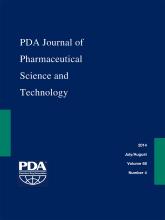Abstract
Glass vials have been used as primary containers for parenteral drugs including biopharmaceuticals. Different types of glass-related particles, although in low occurrence rate, may be adventitiously introduced in these parenterals. Proper classification and investigations of these glass-related particles may help to understand their formation, improve process control, reduce glass-related particles, and deliver safe parenteral drugs to patients. In this article, we introduced a classification scheme, and identification procedures and methods, for the glass-related particles. We propose to classify them as glass chip, glass lamella/flake, and silica gel. Eight characteristics for each glass particle type have been identified and described for the visual inspection method. The limitations of the visual method and the need to correlate visual results with forensic analysis are discussed. Using representative examples from each type of glass particle, this study summarized their forensic differentiations based on microscopic methods of optical microscopy, scanning electron microscopy, micro-flow imaging, and spectroscopic methods of dnergy-dispersive spectroscopy and Fourier transform infrared spectroscopy. The mechanisms of glass particle formation are listed as references for drug development scientists to investigate the root causes and improve process control on visible glass particles in parenteral vials.
LAY ABSTRACT: Glass vials have been used as primary containers for parenteral drugs including biopharmaceuticals. Different types of glass-related particles, although in low occurrence rate, may be adventitiously introduced in these parenterals. Proper classification and investigations of these glass-related particles may help to understand their formation, improve process control, reduce glass-related particles, and deliver safe parenteral drugs to patients. In this article, we introduced a classification scheme, and identification procedures and methods, for the glass-related particles. We propose to classify them as glass chip, glass lamella/flake, and silica gel. Using representative examples from each type of glass particle, this study summarized their forensic differentiations based on microscopic and spectroscopic methods. The mechanisms of glass particle formation are listed as references for drug development scientists to investigate the root causes and improve process control on visible glass particles in parenteral vials.
- © PDA, Inc. 2014
PDA members receive access to all articles published in the current year and previous volume year. Institutional subscribers received access to all content. Log in below to receive access to this article if you are either of these.
If you are neither or you are a PDA member trying to access an article outside of your membership license, then you must purchase access to this article (below). If you do not have a username or password for JPST, you will be required to create an account prior to purchasing.
Full issue PDFs are for PDA members only.
Note to pda.org users
The PDA and PDA bookstore websites (www.pda.org and www.pda.org/bookstore) are separate websites from the PDA JPST website. When you first join PDA, your initial UserID and Password are sent to HighWirePress to create your PDA JPST account. Subsequent UserrID and Password changes required at the PDA websites will not pass on to PDA JPST and vice versa. If you forget your PDA JPST UserID and/or Password, you can request help to retrieve UserID and reset Password below.






